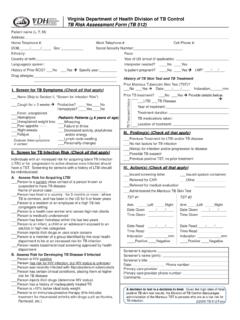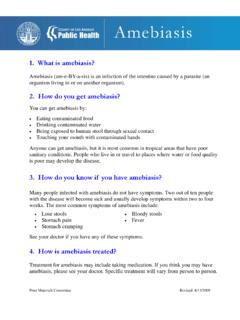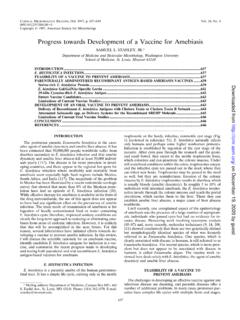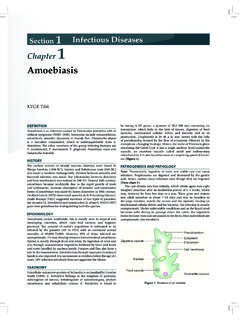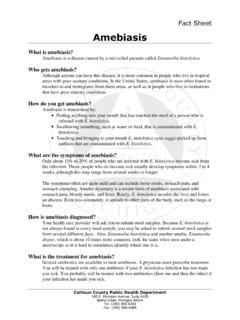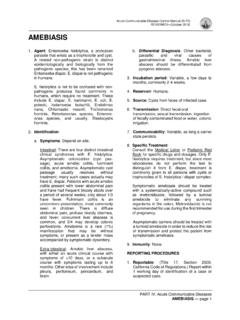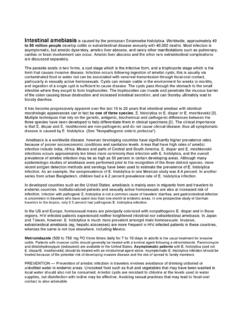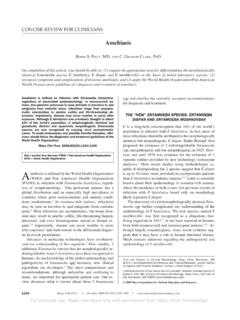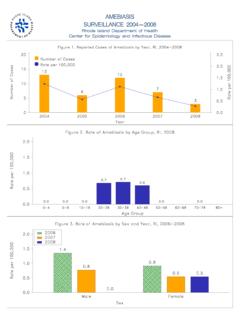Transcription of Amebiasis - Virginia Department of Health
1 Amebiasis Agent: Entamoeba histolytica (parasite) Mode of Transmission: Ingestion of food or water contaminated with amebic cysts, by fecal-oral contact with an infected person, or by swallowing cysts picked up from contaminated surfaces or fingers. Signs/Symptoms: Most infections are asymptomatic. Symptomatic infections are often mild and can include diarrhea, stomach pain, and stomach cramping. Amebic dysentery is a severe form of Amebiasis associated with diarrhea (which may be bloody or contain mucus), abdominal pain, and fever. In a small number of cases, the parasite invades other body sites, such as the liver, lung, brain, or skin. Prevention: Hands should be washed carefully after using the bathroom, after changing diapers or cleaning a child who has used the bathroom, and before preparing and eating food.
2 When traveling to a country with poor sanitary conditions, do not eat or drink: fountain drinks or any drinks with ice cubes; fresh fruit or vegetables that you did not peel yourself; milk, cheese, or dairy products that may not have been pasteurized; anything sold by street vendors; or water unless it is bottled or has been boiled for 1 minute or made safe by filtering it through an "absolute 1 micron or less" filter and dissolving chlorine, chlorine dioxide, or iodine tablets in the filtered water. Other Important Information: Amebiasis can affect anyone, but it is most common in people who live in tropical areas with poor sanitary conditions. In the United States, it is mainly seen in people who travel to or emigrate from these tropical areas, people living in institutions with poor sanitary conditions, and in men who have sex with men.
3 Amebiasis : 2015 Data Summary Number of Cases: 25 5-Year Average Number of Cases: % Change from 5-Year Average: +9% Incidence Rate per 100,000: Twenty-five cases of Amebiasis were reported in Virginia during 2015, which was slightly higher than the five-year average of cases per year (Figure 1). Overall, the number of cases of Amebiasis has decreased since a peak in 2007, in part due to a change in the Rate Number of Cases Year of Report Figure 1. Amebiasis : Ten-Year Trend for Number of Cases and Incidence Rate, Virginia , 2006-2015 Number of CasesIncidence Ratenational surveillance case definition in 2008. This change required that individuals with laboratory-confirmed infection also be symptomatic to be counted for surveillance purposes.
4 Since 2012, the number of reported cases has stabilized. Among cases reported in 2015, the highest incidence rate occurred among adults in the 20-29, 30-39, and 40-49 year age groups ( per 100,000 each), followed closely by the 50-59 and 60 year and older age groups ( per 100,000 each). No cases occurred in infants and only one case occurred in a child less than ten years of age. Race was reported for 56% of the cases. Of those cases with race information provided, the other race population had the highest incidence rate at per 100,000. Incidence was higher in males ( per 100,000) than females ( per 100,000). Fifteen of the twenty-five cases of Amebiasis were reported from the northern Health planning region (incidence rate of per 100,000).
5 Five cases were reported from the eastern region and four cases from the central region ( per 100,000 population each). One case was reported from the southwest region ( per 100,000), and no cases were reported from the northwest region. For incidence rates by locality, please see the map below. Cases occurred throughout the year, with the majority of cases reported during the first quarter (January through March). No outbreaks or deaths attributed to Amebiasis were reported in Virginia in 2015.







